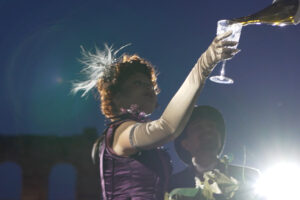
A touring Biennial of Contemporary Art in the Barolo cellars of the Langhe, where one of the most famous wines in the world is born: Barolo. The idea was launched in a cultural salon that brought together the “finance of wine” in the library that once belonged to Giulio Einaudi: Angelo Gaja, Oscar Farinetti, Roberta Ceretto, Paolo Damilano, Lamberto Vallarino Gancia, guests of Gregorio Gitti and Francesca Bazoli, from Brescia and owners of the Castle of Perno, in the Langa, among the vineyards of Nebbiolo today already autumn-colored and still to be harvested. “We have to imagine new ways to talk about culture, wine, Langhe: an art biennial in our beautiful cellars - said Gitti - international banks and lenders are willing to invest”. To offer the opportunity is the presentation of “Stappato. Un astemio alla corte di re Carlo”, the new book written by Tiziano Gaia published by Baldini&Castoldi. The idea launched in the cultural salon is to imagine new languages to tell the Langhe, urged by the journalist of “La Stampa” Roberto Fiori. There are already those who have done so, such as Ceretto with his “Acino” of grapes in the vineyards, or the Cappella delle Brunate, which “colors” Barolo.
“They are estimated between 70 and 80,000 people to see the Cappella di Brunate - said Roberta Ceretto - and we have believed for years in art as a means of communicating wine and now we are about to face a new artistic challenge that costs us like a hectare of Barolo: my father Bruno is the most enthusiastic”. At the round table, there is also a world-famous artist, Emilio Isgrò: “I am usually called to meetings where there is a lack of enthusiasm, but here there is. I have to do what he says: who puts the money in?”.
Oscar Farinetti, on the other hand, expanded on the subject: “We need to bring art a bit to the countryside, get it out of the city. We need to invest to bring people of a certain level here and raise the cultural level. Langa wine should only be sold here more, but we need to think about the structures to accommodate this flow of people. This territory should give a great signal to the world by giving concrete answers on the environment and the migration of peoples. We at Fontanafredda are organic and multiracial. The whole Langa now has to face the great themes of the planet”.
“The Langa - said Angelo Gaja - has been a territory of remarkable entrepreneurial ability, but it does not yet have full awareness of itself. Let me give you an example: the UNESCO project was born in Canelli, in the underground Cathedrals. No one has looked at the beautiful hills of Cassinasco. We have an attitude to look at the details, not the beauty that surrounds us. Our landscapes are art, sung by artists. Every corner is a wonderful discovery. We are the “Princes of the clod”, as Gianni Brera used to say. I would like fewer people to come, but more quality”.
Paolo Damilano, producer, president of the Film Commission Torino and creator of the Castle Foundation, a circuit of castles in Langa and Roero, recalls that “those who come to Turin must come for the city and the cinema, but must also drink Nebbiolo and Barolo. This is not yet the case today. Making a film about wine is not easy: we have evaluated different scripts, but none of them convinced us”. On the unresolved relationship between Turin, the non-capital of Piedmontese food and wine, and its countryside, Lamberto Vallarino Gancia, president of the Teatro Stabile di Torino, is back: “our real problem is communication. A Chinese person met in Turin asked me: how long does it take to fly between Alba and Barolo? We need to make more teams in the region: from the Langa to Monferrato to Turin. We must say that from Turin to the Langa, it takes an hour or so. At the theatre today, 40% of the spectators are under 35 years old but you have to give them modern arguments. My children come to the Langhe to eat and drink well, but also to see the cellars. Our cultural model is an extraordinary container that we still don’t know how to make the most of. We need local players who play and team up”.
Copyright © 2000/2025
Contatti: info@winenews.it
Seguici anche su Twitter: @WineNewsIt
Seguici anche su Facebook: @winenewsit
Questo articolo è tratto dall'archivio di WineNews - Tutti i diritti riservati - Copyright © 2000/2025